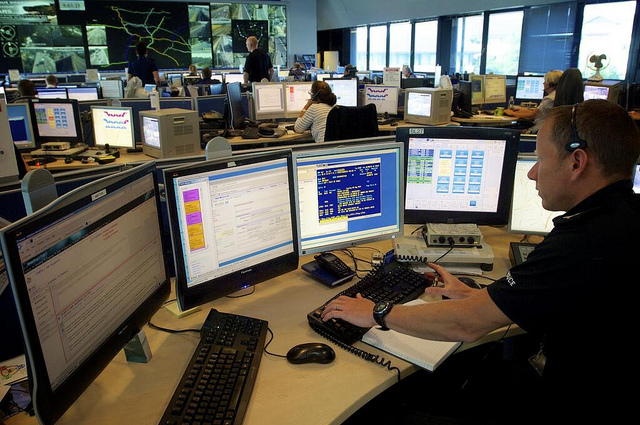
Law enforcement agencies realize the benefits of social media monitoring. Photo credit: West Midlands Police
The law enforcement community is increasingly turning to social media monitoring to prevent and investigate crimes.
Law enforcement agencies participating in a recent LexisNexis survey said social media monitoring has helped them find evidence, identify and locate suspects, solicit tips, and alert the public about crimes. One law enforcement agency used a tip from Tumblr to prevent a teen suicide. Often police find evidence needed to make arrests that criminals themselves post on social media networks.
Of the federal, state and local law enforcement officials surveyed, 81 percent said they use social media for investigations, 67 percent believe social media is valuable for anticipating crime, and 73 percent said it can help solve crimes faster. Police monitoring of social media will continue to grow: 78 percent said they expect to use it even more this year.
A Superb Gang-Fighting Tool
Social media monitoring is especially beneficial in combatting gang activity, according to PoliceOne, a website for law enforcement news. Due to gang culture, gang members are more likely to brag about their exploits in order to increase their stature in their gang and attempt to intimidate other gangs. Cincinnati law enforcement, an early adopter, dismantled a local gang in 2008, arresting 71 people after an extended investigation through social media.
Despite concerns from media commentators and privacy advocates, most (76%) of those surveyed said the use of social media as probable cause for a search warrant has never been challenged.
“By posting and sharing on public social media sites, gang members — in the eyes of the court — often lose their expectation of privacy,” Rick Graham, Law Enforcement Business Development Specialist for LexisNexis Risk Solutions, told PoliceOne.
Lack of Automated Tools Called a Disadvantage
The bad news is that many agencies lack a monitoring tool. Many manually search social media sites one by one. As LexisNexis points out, that’s a labor-intensive, time-consuming process.
Besides saving time, a purpose-built social media monitoring service includes knowledgeable specialists who ensure monitoring is in compliance with changing laws. Being in compliance is critical to assure that courts will accept evidence.
Another issue is that few agencies have formal training, policies or dedicated staff. These shortcomings lead to inconsistent applications between agencies. Three-quarters of respondents say they are self-trained. Only 9% said they had completed training at their agency.
“The adoption of formal policies and processes within agencies will lead to a unified, consistent approach to modern technology usage,” the LexisNexis report states. “As personnel become even more familiar and comfortable using it, they will continue to find robust and comprehensive ways to incorporate emerging social media platforms into their daily routines, thus yielding additional success in interrupting criminal activity, closing cases and ultimately solving crimes.”
Social Media Monitoring Best Practices
Graham recommends these best practices for law enforcement agencies.
∙ Vet and corroborated information before acting on it, just as anonymous tips are corroborated.
∙ Ensure the agency has formal processes and policies in place.
∙ Ensure that the information obtained through social media augments investigations and is not the sole source of information. Although social media information alone is usually not enough to obtain a conviction, it is a valuable tool for collecting evidence.
∙ Use social media to identify and help locate potential witnesses.
∙ Use social media to gather timely information pertaining to situational awareness during an in-progress critical incident, such as in a school shooting, SWAT situation, or hostage negotiation.
Monitoring for Corporations
Corporations also employ social media monitoring to assess threats against their personnel, property and IT infrastructure (including misuse of passwords). Prudent corporations also monitor news and social media for legal threats such as lawsuits, investigations by regulators, human resources threats such as protests or strikes, and information technology threats including hacking.
Many media monitoring services can automatically sort media clips into departmental folders based on keywords, enabling each department to review only those news and social media clips relevant to its issues and concerns. A media monitoring service is more comprehensive than manual monitoring and usually less expensive than assigning staff to do the monitoring.
Bottom Line: Social media monitoring helps law enforcement agencies apprehend criminals and prevent crimes. Yet, monitoring efforts of many police agencies remain unsophisticated. Many departments sift through networks manually without the time-saving benefit of automated monitoring programs, and many lack dedicated staff, formal policies and training programs. Security departments of companies can also benefit from media monitoring services.
William J. Comcowich founded and served as CEO of CyberAlert LLC, the predecessor of Glean.info. He is currently serving as Interim CEO and member of the Board of Directors. Glean.info provides customized media monitoring, media measurement and analytics solutions across all types of traditional and social media.





Trackbacks/Pingbacks